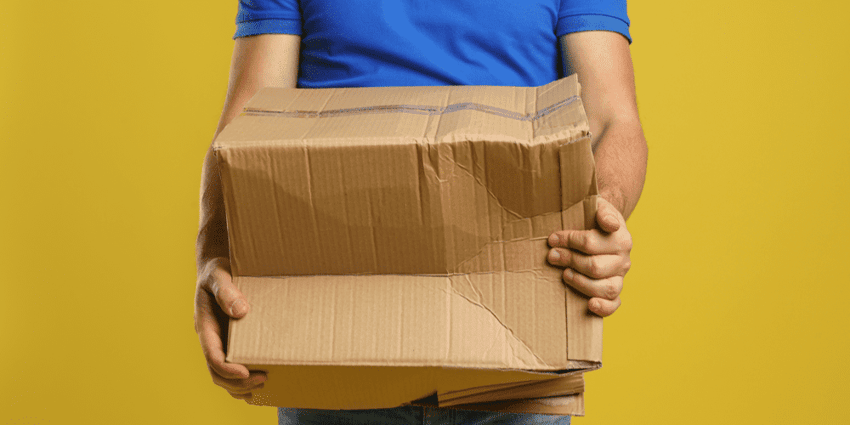It's a harsh reality that damaged and lost products are simply byproducts of doing business - online or offline. In the world of eCommerce, where consumers aren't able to inspect an item before purchasing, and transit is unavoidable the risk of damages and loss increase tenfold.
The cost of a lost product is more than just monetary.
For e-retailers, damaged products can affect customer satisfaction and can be very costly for high-quality products. Not only do they have to replace the damaged goods and send it back to the customer, often any shipping issues are attributed to the e-retailer themselves, potentially losing them business.
Fortunately, there are ways to prevent damage so you can lower your costs and keep your customers happy.
What are the common causes of shipping damages in eCommerce?
Before we get into the how of avoiding freight damage, we have to first understand the common causes of damage in eCommerce:
- Too much empty space in the package
- Not enough cushioning material
- Improper handling and processing
So, what can e-retailers do to lessen the occurrence of freight damages and losses?
Choose proper packaging
Packaging is simple right?
Just find a box and go for it. Errrm...it's a little more difficult than that. You want to make sure that your box or crate is suitable for the item that you're sending.
What do we mean by this? Well, the box you select (and trust us, there's a lot of boxes to choose from) should be only slightly larger than the item you're shipping.
If you're planning on sending your product via a courier delivery or using postal boxes, the best solution is a Mailer Box. They come in various sizes and are made from high-quality, recycled cardboard. Some of the bigger sizes are great for subscription boxes and the smaller sizes can be used for cosmetics, jewellery or clothes.
Too much empty space
Something that often doesn't occur to senders is the empty space within your package. We touched on this point briefly in the previous section, but if your box or mailer is too big for the actual product you're sending, it's more likely that your product will jostle around and get damaged if there isn't enough padding. This is known as void fill.
Not enough cushioning material
Unless your product is highly durable and fits tightly into the shipping box, you will need some sort of void fill or protective packaging material to ensure everything arrives intact. Protective packaging fills several purposes during shipping:
- It takes up extra space in the box to prevent items from shifting during transit
- It cushions the item from shocks and protects any fragile corners
- It improves product presentation and provides a better unboxing experience
- It prevents scrapes and scratches
You have a lot of options when it comes to wrapping, with varying degrees of cushioning.
- Paper
- Poly foam
- Bubble wrap
- Corrugated wrap
Appropriate labelling
Labels are often overlooked when it comes to preventing freight damage. They help shippers make pallet-packing decisions during the shipping process. To ensure precise delivery, your labels should follow these guidelines:
- Remove or completely cover old labels
- Place labels on the top of the box
- Use only one address to avoid confusion
- Do not place labels over a seam or closure on top of sealing tape
- You should always be able to locate a full return address on the shipping label
- Add a secondary label inside the package as well
Adequate palletizing techniques
Make sure that your boxes are full, with no air in them. If your package isn't packed properly, it can easily get damaged on the inside and outside.
How do you pack a pallet for shipping
Make sure the dimensions of your packages are standardized with the correct pallet size. Do not let your package fall outside of the pallet border. Make sure that you boxes are stacked appropriately to distribute the weight evenly. This means heavier boxes are at the bottom, and lighter boxes are at the top. You should also use a sheet in between each third layer to solidify the stack. Don't skimp on the shrink wrap either, wrap the stack two or three times to tightly pack the pallet together to avoid any movement.
Do a trial run or two
If you're working with a new carrier or shipping partner, you can do trial runs or test orders to see if they deliver your packages without being damaged and safely at their destination.
Collect and review data on shipping damages
If you find yourself having a problem with shipping damages, make sure to record every instance. Take note of the type of damage, how it happened (with photographs) and with which courier it happened with. Doing so can help you to prevent these damages from reoccuring.
Choose the right carrier
Ultimately, reducing your freight shipping damage claim rate boils down to choosing the right courier partner(s) to work with. There's no point in following these tips, if your courier partner doesn't. When you choose to ship with Interparcel, you're getting access to the largest multicarrier network. With the likes of FedEx, Startrack and TNT, you'll be able to pick and choose the right carrier to ship your goods with.
What can I do if my shipment has been damaged
Only the registered sender is eligible to start a claim. This means the person that placed and paid for the order. They will need to provide the original packaging and photographs of the parcel in their claim.
If you want to start a claim, you will need to contact the customer service team first. You will need the following to process a claim:
- Photograph of the item
- Photograph and description of the packaging
- An invoice showing the value of the consignment
- A copy of the claim document (which will be sent to you)










 Facebook
Facebook Twitter
Twitter Instagram
Instagram Linked In
Linked In YouTube
YouTube